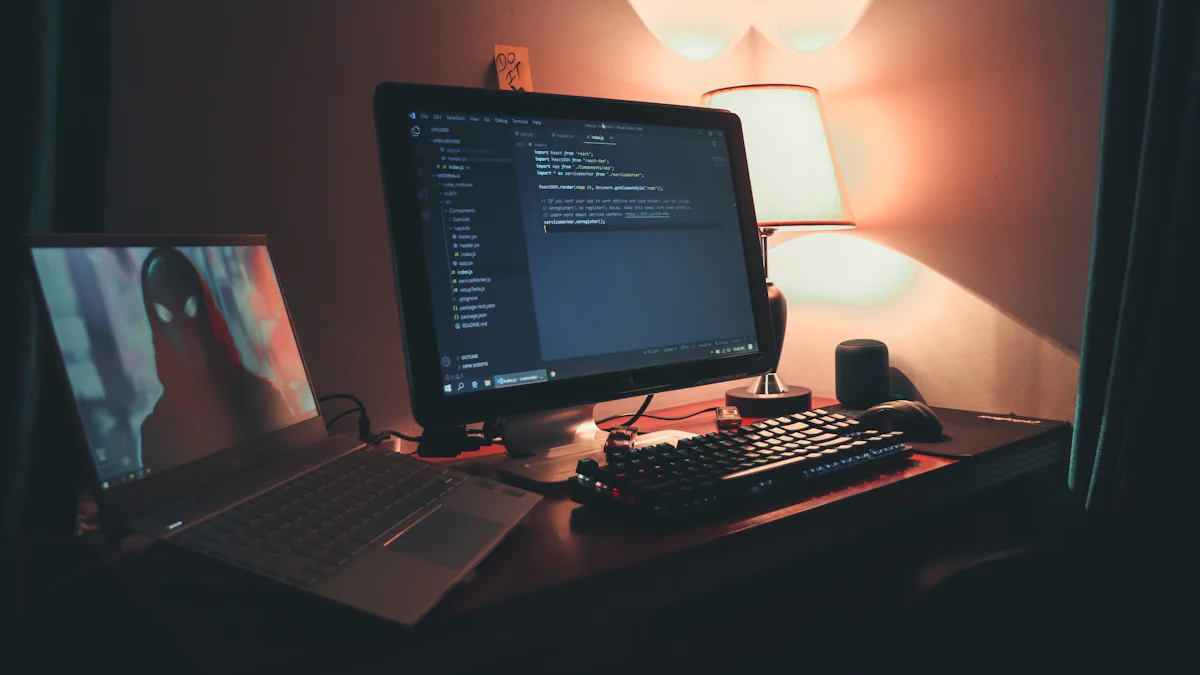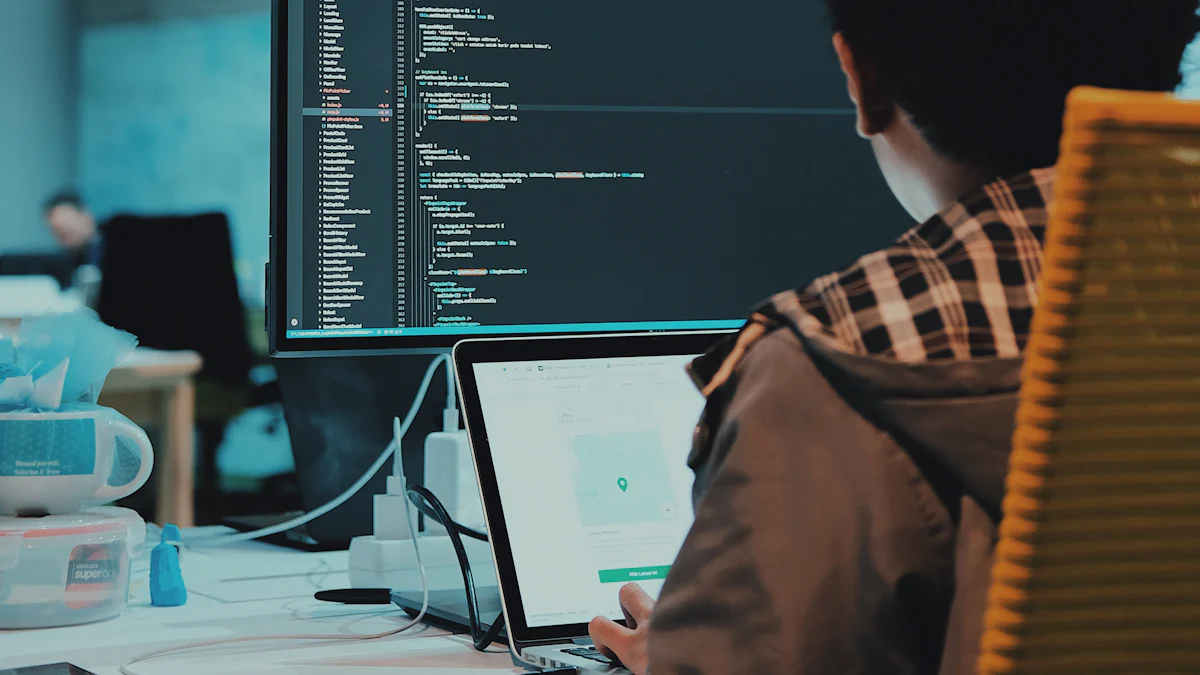Comprehensive Guide to Processing Programming Books

Processing empowers artists and designers to explore the intersection of technology and creativity. This open-source programming language simplifies complex coding concepts, making it accessible to individuals without a computer science background. It has revolutionized creative coding by enabling users to produce interactive visuals, animations, and generative art. Professionals and hobbyists alike use Processing for projects ranging from multimedia installations to data visualizations. Its versatility and ease of use have made it a cornerstone for those seeking to integrate programming into their artistic endeavors.
Key Takeaways
Processing is an accessible programming language that empowers artists and designers to create interactive visuals and generative art without needing a computer science background.
Learning Processing opens up new creative possibilities, allowing users to merge artistic expression with computational logic, enhancing their skill set in technology-driven fields.
Beginner-friendly books like 'Getting Started with Processing' and 'Learning Processing' simplify complex concepts, making them ideal for those new to programming.
Intermediate learners can benefit from 'Generative Design,' which explores advanced techniques in generative art and encourages experimentation.
Hands-on learning through project-based books fosters creativity and problem-solving skills, enabling readers to apply their knowledge in real-world scenarios.
The Processing community offers extensive resources, including tutorials and forums, providing support and inspiration for learners at all levels.
Authors like Casey Reas, Ben Fry, and Daniel Shiffman bring credibility and depth to their books, ensuring readers receive accurate information and practical insights.
Why Learn Processing Programming?
The Role of Processing in Creative Coding
Processing plays a pivotal role in the realm of creative coding. Designed with simplicity and accessibility in mind, it empowers creators to transform abstract ideas into tangible visual outputs. Unlike traditional programming languages such as Java, Processing offers a streamlined syntax tailored for artists and designers. Its integrated development environment (IDE) simplifies the coding process, enabling users to focus on creativity rather than technical complexities. By bridging the gap between technology and art, Processing has become a cornerstone for those exploring interactive installations, generative art, and multimedia projects.
Processing also stands out due to its adaptability. It supports extensions and libraries that cater to diverse creative needs, from 3D modeling to data visualization. This flexibility allows users to experiment with innovative concepts while maintaining a user-friendly experience. Furthermore, Processing's ability to translate code into Java at runtime ensures robust performance, making it a reliable tool for both beginners and experienced programmers.
Benefits of Learning Processing for Artists and Designers
For artists and designers, learning Processing opens up a world of possibilities. It provides a platform to merge artistic expression with computational logic, fostering unique creations that would be challenging to achieve through traditional methods. Processing's simplified syntax reduces the learning curve, making it accessible even to those without prior programming experience. This ease of use encourages experimentation, allowing creators to explore new techniques and push the boundaries of their craft.
Processing also enhances professional opportunities. Many industries value the ability to integrate technology into design processes, and proficiency in Processing can set individuals apart in competitive fields. Whether it's creating interactive exhibits, designing digital art, or developing animations, Processing equips artists and designers with the skills needed to thrive in a technology-driven world. Additionally, its extensive documentation and active community provide valuable resources for continuous learning and growth.
Applications of Processing in Real-World Projects
Processing's versatility extends to a wide range of real-world applications. In the field of education, it serves as an effective tool for teaching programming concepts through visual and interactive examples. Educators use Processing to engage students by demonstrating how code can create dynamic visuals and animations. This approach not only simplifies complex topics but also inspires creativity among learners.
In the professional sphere, Processing has been utilized in various industries, including advertising, architecture, and entertainment. Designers leverage its capabilities to create immersive installations and interactive displays, while architects use it for visualizing complex structures. Additionally, Processing's ability to handle data visualization makes it a valuable asset for researchers and analysts seeking to present information in an engaging and comprehensible manner.
Processing's impact is further amplified by its compatibility with other tools and platforms. For instance, p5.js and Processing.py extend its functionality to JavaScript and Python, enabling creators to develop web-based projects and mobile applications. This adaptability ensures that Processing remains relevant in an ever-evolving technological landscape.
Top Books for Beginners

"Getting Started with Processing" by Casey Reas and Ben Fry
Overview of the book's content and structure
"Getting Started with Processing" serves as an excellent entry point for individuals new to programming. Written by Casey Reas and Ben Fry, the creators of Processing, this book introduces readers to the fundamentals of the language in a clear and concise manner. It begins with an overview of the Processing environment, guiding users through installation and setup. The chapters progress logically, covering essential topics such as drawing shapes, working with colors, and creating animations.
The book adopts a hands-on approach, featuring numerous examples and exercises that encourage readers to experiment with code. Each chapter builds on the previous one, ensuring a smooth learning curve. By the end of the book, readers will have a solid understanding of Processing's core concepts and the confidence to create their own projects.
Why it's ideal for beginners
This book is ideal for beginners because it simplifies complex programming concepts. The authors use straightforward language and practical examples to make learning accessible. The step-by-step instructions help readers grasp the basics without feeling overwhelmed. Additionally, the book's focus on visual outcomes makes it particularly appealing to artists and designers who may lack prior coding experience. Its approachable style and emphasis on creativity make it a perfect starting point for anyone interested in Processing.
"Processing: A Programming Handbook for Visual Designers and Artists" by Casey Reas and Ben Fry
Key features and learning outcomes
"Processing: A Programming Handbook for Visual Designers and Artists" offers a comprehensive guide to mastering Processing. This book delves deeper into the language, providing a thorough exploration of its capabilities. It covers a wide range of topics, including advanced drawing techniques, interactivity, and data visualization. The authors include detailed explanations, code snippets, and visual examples to illustrate key concepts.
One of the standout features of this book is its emphasis on bridging the gap between programming and visual arts. It encourages readers to think creatively and use Processing as a tool for artistic expression. The book also includes interviews with artists and designers who share insights into their creative processes, inspiring readers to explore new possibilities.
How it bridges the gap between coding and visual arts
This handbook excels at connecting coding with visual arts by presenting programming as a medium for creativity. It demonstrates how Processing can be used to create generative art, interactive installations, and multimedia projects. The authors highlight the importance of experimentation and iteration, encouraging readers to push the boundaries of their work. By combining technical knowledge with artistic inspiration, this book empowers readers to harness the full potential of Processing.
"Learning Processing: A Beginner's Guide to Programming Images, Animation, and Interaction" by Daniel Shiffman
Overview of content and structure
Daniel Shiffman's "Learning Processing" provides a structured and engaging introduction to the language. The book adopts a lab-style format, offering a mix of theoretical explanations and practical exercises. It begins with the basics, such as setting up the environment and understanding syntax, before progressing to more advanced topics like animation, interactivity, and object-oriented programming.
Each chapter includes clear explanations, annotated code examples, and exercises designed to reinforce learning. The book also features a companion website with additional resources, including video tutorials and downloadable code. This comprehensive approach ensures that readers not only understand the material but also gain hands-on experience.
Why it's recommended for beginners
This book is highly recommended for beginners due to its approachable style and emphasis on practical learning. Shiffman breaks down complex topics into manageable pieces, making them easy to understand. The interactive exercises and real-world examples help readers apply their knowledge and build confidence. Furthermore, the book's focus on images, animation, and interaction aligns perfectly with the interests of artists and designers. Its engaging format and supportive resources make it an invaluable tool for anyone starting their journey with Processing.
Intermediate and Advanced Books
"Generative Design: Visualize, Program, and Create with Processing" by Hartmut Bohnacker, Benedikt Gross, and others
Focus on generative art and advanced techniques
"Generative Design: Visualize, Program, and Create with Processing" stands out as a definitive guide for those interested in exploring the intersection of art and technology. This book delves into the realm of generative art, where algorithms and code become tools for creating intricate and dynamic visuals. The authors, Hartmut Bohnacker, Benedikt Gross, and their collaborators, provide a detailed exploration of advanced techniques that push the boundaries of creativity.
The book introduces readers to the principles of generative design, emphasizing the role of randomness, repetition, and iteration in producing unique artistic outputs. It includes step-by-step tutorials and code examples that guide users through complex concepts, making them accessible to intermediate and advanced learners. By focusing on the creative potential of Processing, this book inspires readers to experiment with innovative approaches and develop their own artistic style.
Practical projects and real-world applications
One of the book's strengths lies in its emphasis on practical projects. Each chapter features hands-on exercises that encourage readers to apply their knowledge and create tangible results. From designing intricate patterns to developing interactive installations, the projects demonstrate the versatility of Processing in real-world scenarios.
The authors also highlight the applications of generative design in various industries, such as graphic design, architecture, and digital media. By showcasing examples of professional work, they illustrate how Processing can be used to solve creative challenges and produce visually stunning outcomes. This practical focus makes the book an invaluable resource for artists, designers, and programmers seeking to expand their skill set.
"Learning Processing: A Beginner's Guide to Programming Images, Animation, and Interaction" by Daniel Shiffman
Why it's suitable for intermediate learners
While "Learning Processing" by Daniel Shiffman is often recommended for beginners, its comprehensive content also makes it an excellent choice for intermediate learners. The book builds on foundational concepts and introduces more advanced topics, such as object-oriented programming, interactivity, and animation. Shiffman's clear explanations and engaging writing style ensure that readers can grasp these complex ideas without feeling overwhelmed.
Intermediate learners will benefit from the book's structured approach, which gradually increases in complexity. The inclusion of annotated code examples and practical exercises allows readers to deepen their understanding and refine their skills. By revisiting the basics and exploring advanced techniques, this book provides a solid foundation for tackling more challenging projects.
Key topics covered, such as interactivity and animation
The book covers a wide range of topics that are essential for intermediate learners. It explores the principles of interactivity, teaching readers how to create programs that respond to user input. This includes techniques for handling mouse and keyboard events, as well as incorporating sensors and other external devices.
Animation is another key focus of the book. Shiffman explains how to use Processing's built-in functions to create smooth and dynamic animations. He also introduces concepts like frame rate, easing, and motion paths, enabling readers to bring their creations to life. These topics, combined with the book's emphasis on experimentation and creativity, make it a valuable resource for those looking to advance their skills.
"Processing for Visual Artists: How to Create Expressive Images and Interactive Art" by Andrew Glassner
Overview of content and structure
"Processing for Visual Artists" by Andrew Glassner offers a deep dive into the creative possibilities of Processing. The book is designed for experienced learners who want to explore the language's full potential. It begins with an overview of Processing's capabilities, followed by a series of chapters that cover topics such as drawing, animation, interactivity, and data visualization.
Glassner adopts a project-based approach, presenting readers with a variety of challenges that encourage hands-on learning. Each project is accompanied by detailed explanations and code examples, ensuring that readers understand the underlying concepts. The book also includes discussions on artistic principles and design considerations, providing a well-rounded perspective on the creative process.
Why it's recommended for experienced learners
This book is particularly suited for experienced learners due to its focus on advanced techniques and artistic expression. Glassner assumes that readers have a basic understanding of programming, allowing him to delve into more complex topics without spending time on introductory material. The projects are designed to challenge readers and inspire them to think critically about their work.
In addition to technical skills, the book emphasizes the importance of creativity and experimentation. Glassner encourages readers to push the boundaries of their abilities and explore new ideas. By combining technical expertise with artistic insight, this book equips experienced learners with the tools they need to create expressive and impactful works of art.
Creative Applications and Project-Based Learning

Books Focused on Practical Applications
"Processing for Visual Artists: How to Create Expressive Images and Interactive Art" by Andrew Glassner
Andrew Glassner's "Processing for Visual Artists" provides a practical approach to mastering Processing. The book emphasizes creating expressive images and interactive art, making it an essential resource for those who want to explore the artistic potential of programming. Glassner adopts a project-based methodology, guiding readers through real-world challenges that encourage hands-on learning. Each project includes detailed explanations and annotated code, ensuring that readers understand both the technical and creative aspects of their work.
The book also delves into the principles of design and artistic expression. Glassner encourages readers to experiment with different techniques and push the boundaries of their creativity. This focus on exploration makes the book particularly valuable for artists and designers seeking to integrate technology into their creative processes. By combining technical knowledge with artistic insight, Glassner equips readers with the skills needed to create impactful and innovative works of art.
"Generative Design: Visualize, Program, and Create with Processing" by Hartmut Bohnacker, Benedikt Gross, and others
"Generative Design" by Hartmut Bohnacker, Benedikt Gross, and their collaborators stands out as a definitive guide for exploring the intersection of art and technology. The book focuses on generative art, where algorithms and code serve as tools for creating intricate and dynamic visuals. It introduces readers to advanced techniques, such as randomness, repetition, and iteration, which are essential for producing unique artistic outputs.
The authors provide step-by-step tutorials and code examples that make complex concepts accessible to learners. Each chapter features practical projects that demonstrate the versatility of Processing in real-world scenarios. From designing intricate patterns to developing interactive installations, the book showcases the creative potential of programming. By highlighting applications in fields like graphic design, architecture, and digital media, "Generative Design" inspires readers to experiment with innovative approaches and develop their own artistic style.
How These Books Help Build Real-World Skills
Examples of projects and their applications
Both books offer numerous examples of projects that demonstrate the practical applications of Processing. For instance, Glassner's book includes projects focused on creating interactive installations and visual experiments. These projects help readers understand how to use Processing to develop engaging and immersive experiences. Similarly, "Generative Design" features projects that explore the principles of algorithmic art, such as designing complex patterns and visualizing data.
These examples highlight the versatility of Processing in various fields. Artists can use it to create generative art and multimedia installations, while designers can leverage its capabilities for interactive displays and animations. The books also emphasize the importance of experimentation, encouraging readers to explore new techniques and push the boundaries of their creativity.
Benefits of hands-on learning
Hands-on learning plays a crucial role in mastering Processing. Both books adopt a project-based approach that allows readers to apply their knowledge in practical scenarios. This method not only reinforces theoretical concepts but also helps readers develop problem-solving skills. By working on real-world projects, learners gain a deeper understanding of the language and its capabilities.
The emphasis on hands-on learning also fosters creativity and innovation. Readers are encouraged to experiment with different techniques and explore new ideas, which helps them develop their own artistic style. Additionally, the practical focus of these books ensures that readers acquire skills that are directly applicable to their professional work. Whether it's creating interactive installations or designing generative art, the knowledge gained from these books equips readers to tackle creative challenges with confidence.
Author Insights and Reviews
Background of Key Authors
Casey Reas and Ben Fry: Founders of Processing
Casey Reas and Ben Fry, the creators of Processing, have profoundly influenced the creative coding landscape. Their vision transformed programming into an accessible tool for artists and designers. Reas and Fry developed Processing as a "software sketchbook," enabling users to experiment with code in a visual and intuitive way. This approach bridged the gap between technology and art, fostering creativity among individuals without a technical background.
"Processing was created for artists in order for them to achieve software literacy. It has specially crafted commands that offer artists more visual feedback and immediate results." – Casey Reas
Their work extended the ideas of their mentor, John Maeda, by evolving the DBN (Design By Numbers) framework into Processing. This Java-based platform gained immense popularity due to its simplicity and versatility. Over the years, Processing has grown into a high-performance environment for computer graphics and interactive installations, as highlighted by Reas:
"It started as a software 'sketchbook' and environment for classrooms, but it has also emerged as a high-performance environment for computer graphics and interactive installations." – Casey Reas
Reas and Fry's contributions have not only shaped the Processing community but also inspired countless artists and designers to explore the possibilities of creative coding.
Daniel Shiffman: Renowned Educator and Creative Coder
Daniel Shiffman, a professor at the Tisch School of the Arts at New York University, has become a prominent figure in the Processing community. Known for his engaging teaching style, Shiffman has introduced programming to a global audience through his books, tutorials, and online videos. His work emphasizes the creative potential of coding, making complex concepts accessible to learners of all levels.
"Within these pages, ITP professor Daniel Shiffman demonstrates the fundamentals of programming that will expand your understanding of what is possible in the world of computer graphics." – Daniel Shiffman
Shiffman's book, "Learning Processing", exemplifies his commitment to education. It provides a structured and interactive approach to learning, focusing on images, animation, and interaction. His ability to simplify technical topics while inspiring creativity has made him a trusted resource for aspiring programmers and artists alike.
Why Author Expertise Matters
Credibility and Depth of Knowledge
The expertise of authors like Reas, Fry, and Shiffman adds immense value to their books. Their deep understanding of Processing ensures that readers receive accurate and reliable information. As the creators of the language, Reas and Fry offer unparalleled insights into its design and functionality. Their firsthand experience allows them to explain concepts with clarity and precision, making their books indispensable for learners.
Shiffman's background as an educator further enhances his credibility. His ability to break down complex topics into manageable steps reflects his mastery of both programming and teaching. Readers benefit from his practical approach, which combines theoretical knowledge with hands-on exercises.
How Their Experience Enhances the Learning Process
The authors' experiences shape the way they present information, making it engaging and relevant. Reas and Fry's focus on artistic expression encourages readers to think creatively and experiment with code. Their emphasis on "sketching with code" aligns with the needs of artists and designers, fostering a sense of exploration and play.
Shiffman's teaching philosophy prioritizes accessibility and interaction. His books and tutorials guide readers through the learning process, building confidence and competence. By incorporating real-world examples and projects, he helps learners apply their skills in meaningful ways.
The collective expertise of these authors ensures that their books not only teach programming but also inspire creativity. Their contributions have made Processing an essential tool for anyone seeking to merge technology with art.
FAQs and Additional Resources
Common Questions About Learning Processing
"Do I need prior programming experience?"
No prior programming experience is necessary to start learning Processing. The language was designed to be beginner-friendly, making it accessible to individuals without a technical background. Its simplified syntax and intuitive environment allow users to focus on creativity rather than complex coding concepts. Many resources, such as books and tutorials, cater specifically to beginners, ensuring a smooth learning curve. For instance, Daniel Shiffman's "Learning Processing" provides step-by-step guidance, making it an excellent starting point for those new to programming.
"What tools do I need to get started?"
To begin with Processing, only a computer and the Processing software are required. The software is free to download from Processing.org, the official website. It runs on Windows, macOS, and Linux, ensuring compatibility with most systems. The installation process is straightforward, and the website provides detailed instructions to guide users. Additionally, the software includes an integrated development environment (IDE) that simplifies writing, testing, and running code. Beginners can also explore the "Hello Processing" videos available online, which offer an engaging introduction to the platform.
Recommended Online Resources and Communities
Processing.org and its tutorials
Processing.org serves as the central hub for all things related to Processing. It offers a wealth of resources, including comprehensive tutorials, reference guides, and example projects. The tutorials cover a wide range of topics, from basic drawing techniques to advanced interactivity and animation. These materials cater to learners of all levels, providing a solid foundation for beginners and advanced insights for experienced users.
The website also features a vibrant showcase of projects created by the Processing community. These examples inspire learners by demonstrating the creative possibilities of the language. Additionally, the reference section provides detailed explanations of Processing's functions and syntax, making it an invaluable tool for troubleshooting and learning.
Online forums and creative coding communities
The Processing community extends beyond its official website, thriving on various online platforms. Forums like the Processing Discourse allow users to ask questions, share projects, and connect with other enthusiasts. These forums foster collaboration and provide a supportive environment for learners at all stages.
Social media platforms and creative coding communities also play a significant role in promoting Processing. Websites like Reddit and GitHub host discussions and repositories related to Processing, offering additional learning opportunities. For visual learners, YouTube channels such as The Coding Train by Daniel Shiffman provide engaging video tutorials that simplify complex concepts. These resources ensure that learners have access to a diverse range of materials and support networks as they explore Processing.
Selecting the right book depends on individual skill levels and learning objectives. Beginners can start with "Getting Started with Processing" or "Learning Processing", which simplify programming concepts and focus on visual creativity. Intermediate learners may benefit from "Generative Design", offering advanced techniques in generative art. Experienced users can explore "Processing for Visual Artists", which emphasizes expressive and interactive art.
Readers should explore these books to begin their journey in Processing programming. Combining book learning with hands-on practice enhances understanding and fosters creativity. Processing serves as a gateway to mastering programming while empowering artistic expression.
See Also
Discovering Zhongkai's Unexpected Advantages for Mobile Manufacturing
Boosting the Electronics Sector: The Journey of Zhongkai High-tech
Leading Innovators in the Worldwide Smart Control Sector
Investigating Expansion Opportunities in Huizhou Zhongkai Tech Area
Zhongkai High tech Zone National foreign trade transformation and Upgradi Base(Electronic Information)Cloud Platform.
Address: Zhongkai High-tech Zone,Huizhou City ,Guangdong,China
E-mail: huizhoueii@163.com 13510001271@163.com
Tel: +86-0752-3279220 Mobile: +86-13510001271


